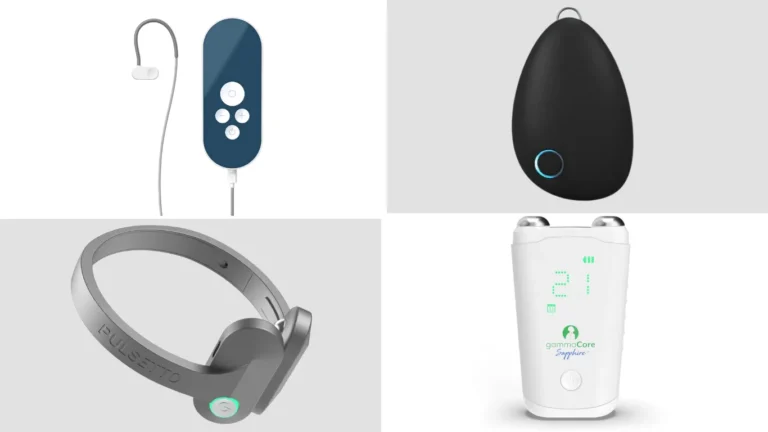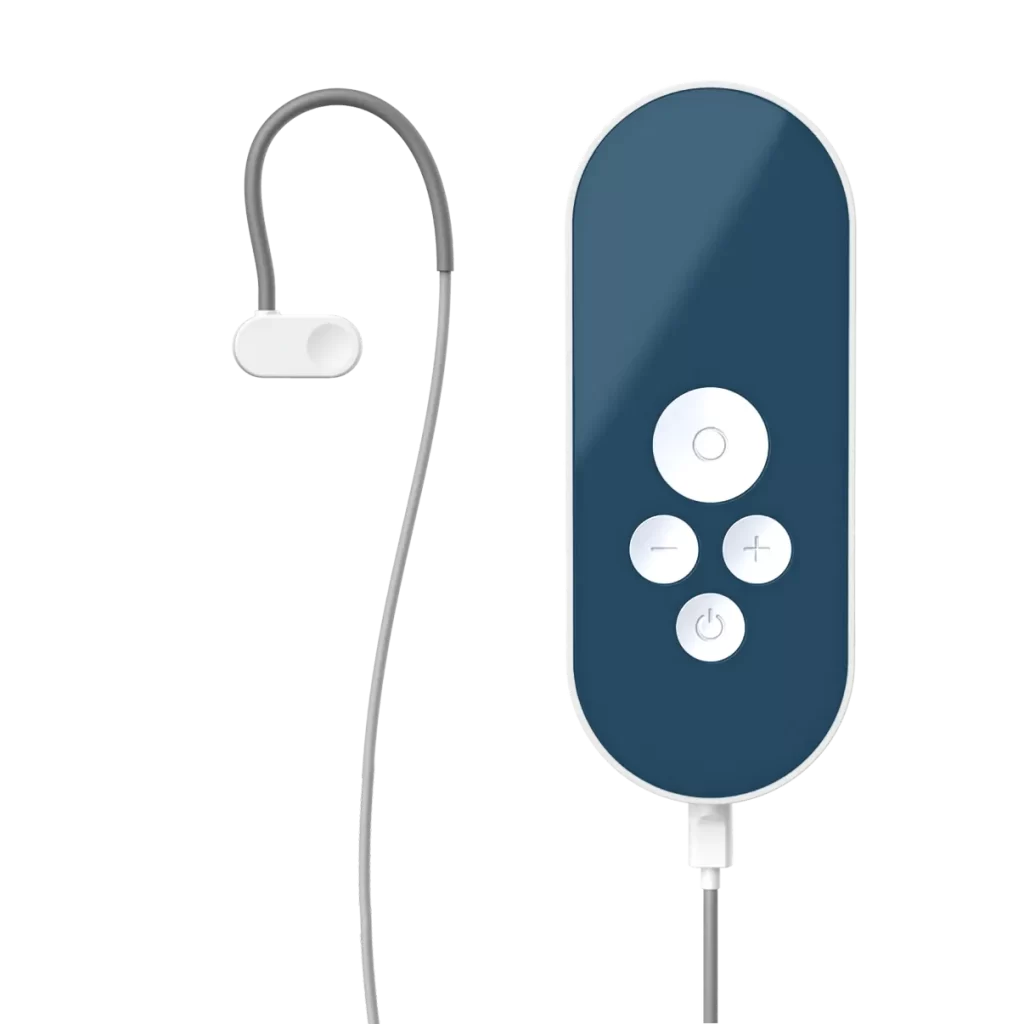My Testing Protocol
Since these devices are NOT created equal, it’s essential to carefully evaluate their features, effectiveness, and user experience before making a decision. So we set out to compare four of the most popular devices that people purchase for vagus nerve stimulation – Pulsetto, Sensate, Gammacore, and Nuropod. However, it’s important to note that unlike Nuropod and GammaCore, Pulsetto and Sensate are not certified VNS devices.
For an accurate comparison, we had each device evaluated by a team of PhDs and medical doctors. I used each device for one month, with a one-month break after each to avoid any carryover effects. I started with Sensate, then Pulsetto, Nuropod, and finally, GammaCore.
Here are the results and rankings:
| Nuropod | Gammacore | Pulsetto | Sensate | |
| Evaluated in and supported by peer-reviewed placebo-controlled clinical trials | ✓ | ✓ | Χ | Χ |
| Number of clinical trials conducted | 50+ | 20+ | 0 | 0 |
| Clinical trial investment | $10M+ | $50M+ | $0 | $0 |
| Usable without app | ✓ | Χ | Χ | Χ |
| Available without prescription | ✓ | Χ | ✓ | ✓ |
| Mode of action | Auricular Vagal Neuromodulation Therapy (AVNT) | Non-invasive Cervical Vagus Nerve Stimulation (ncVNS) | No validated mode of action | No validated mode of action |
| Target site | Auricular branch of the vagus nerve | Cervical branch of the vagus nerve | Neck | Chest |
| Delivery | Proprietary (Electrical) | Proprietary (Electrical) | Electrical | Vibration |
| Pleasantness of stimulation | Pleasant, mild | More intense, can clench a jaw | More intense | No direct stimulation, pleasant vibratio |
| Is gel needed to use? | No | Yes | Yes | No |
| Battery Life | >1 month | 1 week | 1 week | 1 week |
| Easy to travel with | Yes | No | No | Yes |
| Device type requiring regulatory review and approval before marketing | Required | Required | Required | Χ |
| Approved to be used by the public | ✓ | ✓ | Χ | n/a |
| Certified Medical Device | ✓ | ✓ | Χ | Χ |
| Medical evaluation process on purchase | ✓ | ✓ | Χ | Χ |
| Documented safety controls | ✓ | ✓ | Χ | Χ |
| SAE (serious adverse events) reported in clinical study | 0 | 0 | No clinical evaluation. Adverse events have been reported online | No clinical evaluation. |
| Risk profile | Low risk based on clinical trials | Low risk based on clinical trials | High risk based on lack of clinical trials and user reports | Low risk based on delivery (vibration) |
| Initial cost | $900 | £350 (first 3 months only) | £209.20 | £299 |
| Additional costs | $0 | $598 per month | £99.99 GBP per year Paid app with more features | £50 per year Paid app with more features |
| Total estimated cost over 5 years of daily use | $900 | $14000.23 | $926.32 | $717.12 |
| Overall Recommendation | Our top pick – Highly recommended | Recommended for migraine sufferers | Not recommended | Can be used as a supplementary tool |
Nuropod
Recommendation: Our top pick – Highly recommended
Price: 900 USD
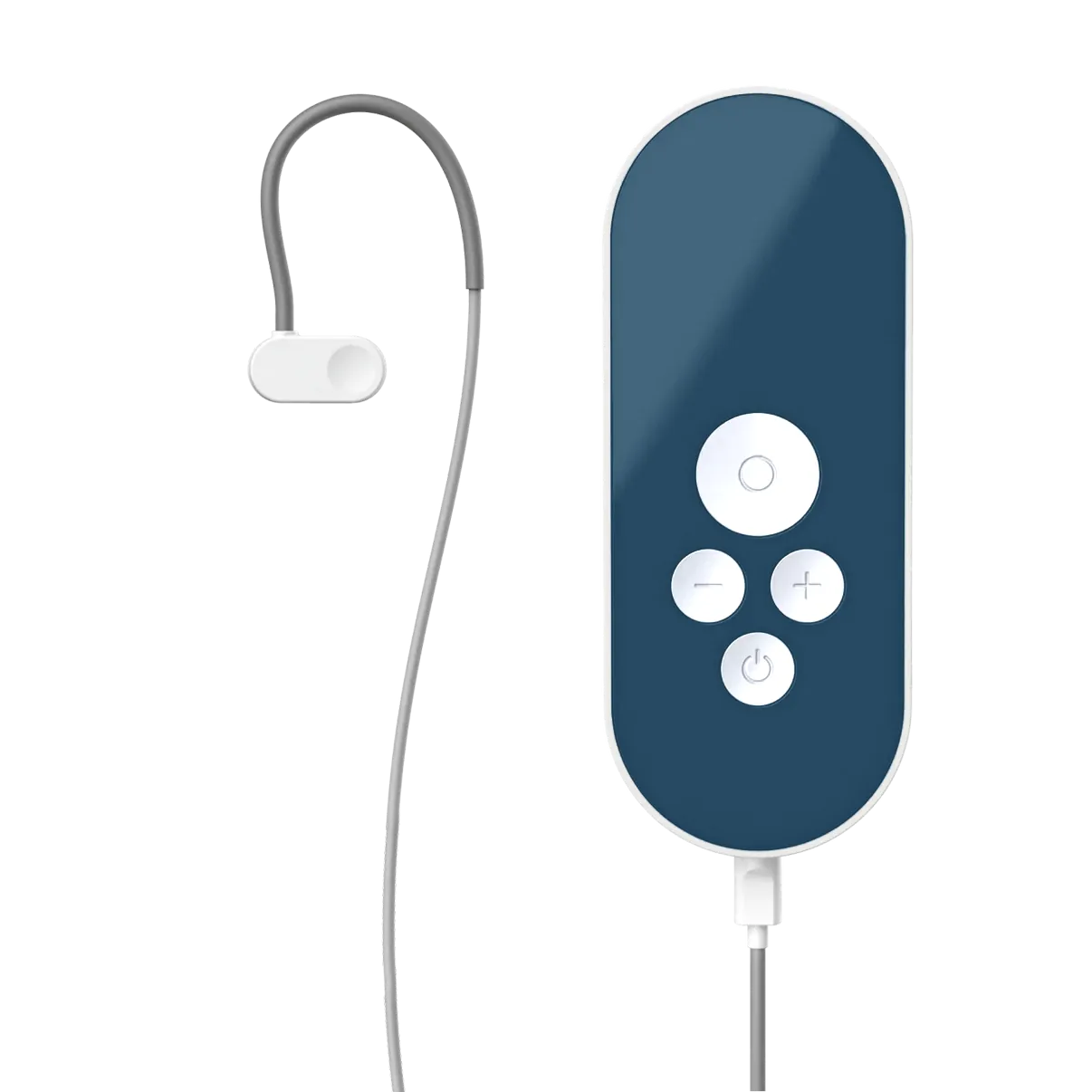
Nuropod is the first CE-Marked Medical Device in our evaluation, which means that its safety and efficacy have been clinically validated. In fact, Nuropod established a new device category with their Auricular Vagal Neuromodulation Therapy (AVNT), which led to acquiring medical device status and paving the way for a new standard in vagus nerve technology. Also, unlike GammaCore, you don’t need a prescription to purchase it.
Unlike other devices on the list, it’s backed by 40+ peer-reviewed clinical studies including many Randomised Placebo Controlled Studies conducted on renowned academic institutions such as Harvard, UCLA, Bart’s Health NHS Trust, and more. It is the most extensively studied and utilized non-invasive VNS device by researchers and doctors.
And for good reason––the results of Nuropod’s studies are striking. For example, researchers found in various clinical populations a 35% improvement in anxiety, 45% improvement in depression score, a 19% improvement in sleep, and a 48% improvement in fatigue, just to name a few.
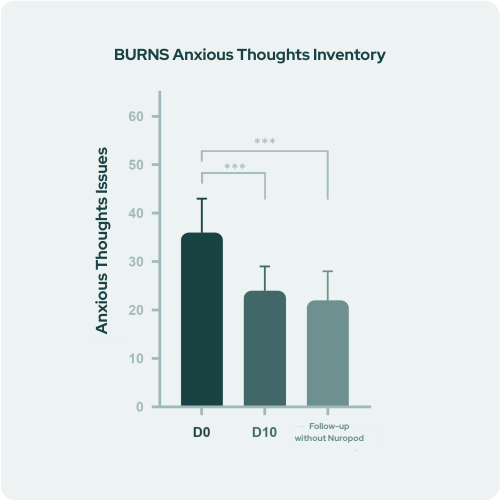
Nuropod’s clinical results show significant improvement in a wide range of chronic and acute conditions affecting millions of people worldwide.
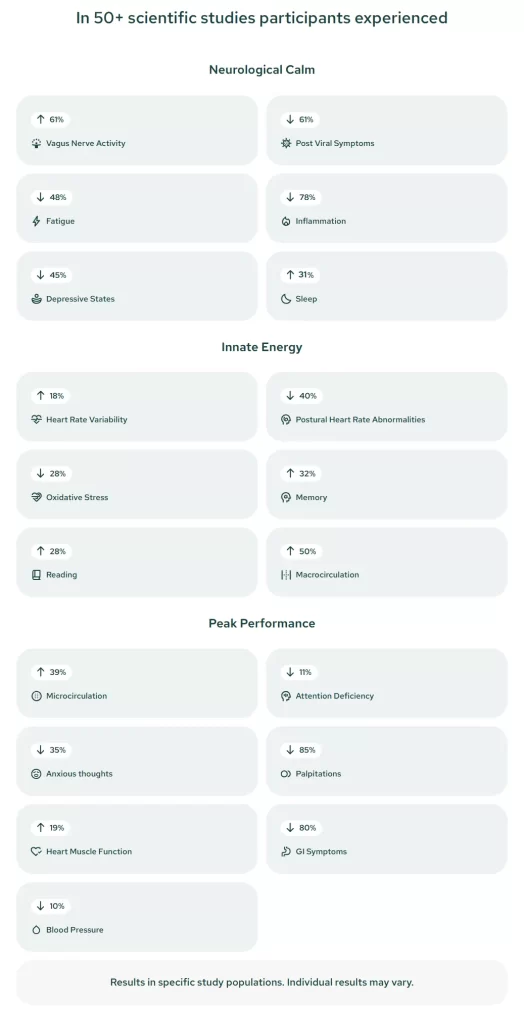
Personally, Nuropod was transformative for my anxiety and fatigue. As we age, our sympathetic nervous system becomes overactive, leading to increased inflammatory processes throughout the body. By harnessing the power of advanced neuromodulation technology, Nuropod offers a safe, easy, and effective solution for restoring your health and well-being.
After just a week of use, I noticed a huge difference in my overall well-being and I felt amazing by the end of the month. It is convenient to wear on the ear, and doesn’t require a gel which makes a huge difference. I found it easy to build a routine of daily use as with all VNS devices, consistency of daily use is important to see results. It is also easy to travel with and the battery lasts a lifetime. I did not have to charge it even once within the period of the test.
Best of all, it is a clinically-validated technology trusted by leading medical institutions and used by hundreds of doctors worldwide.
Key Features & Observations:
- Clinically validated in 3,000,000+ treatment sessions for safety & efficacy
- Patented technology targeting the vagus nerve for rapid results
- Precise signal delivery and targeting
- Easy to use and comfortable to wear like an earphone any time of day use
- Portable design that’s easy to travel with in your pocket
- Doesn’t require a gel to use
- Long battery life (battery lasted for a month)
- Durable construction and 2-year warranty
- No subscription necessary
- 30-day risk-free trial and full refund guarantee
Overview
| Nuropod | |
| Price | 900 USD |
| How it’s used | Worn on the left ear |
| Ease of use | Excellent |
| Targeting the vagus nerve | Unilateral targeting of vagus nerve through the left ear |
| Battery life | 1 month |
| Key risks | No serious adverse events identified in clinical trials and peer-reviewed studies |
| Clinical benefits | 40+ peer-reviewed studies showing positive results in relieving symptoms of fatigue, gastrointestinal issues, mood, anxiety, depression score, cognitive performance and heart rate variability |
| Risk Profile | Very low |
| Scientific assessment | Highly recommended |
GammaCore
Recommendation: Recommended for migraine sufferers
Price: 2,079.33 EUR for the first year (415.87 EUR first 3 months then 554.49 EUR per 3 months after that)
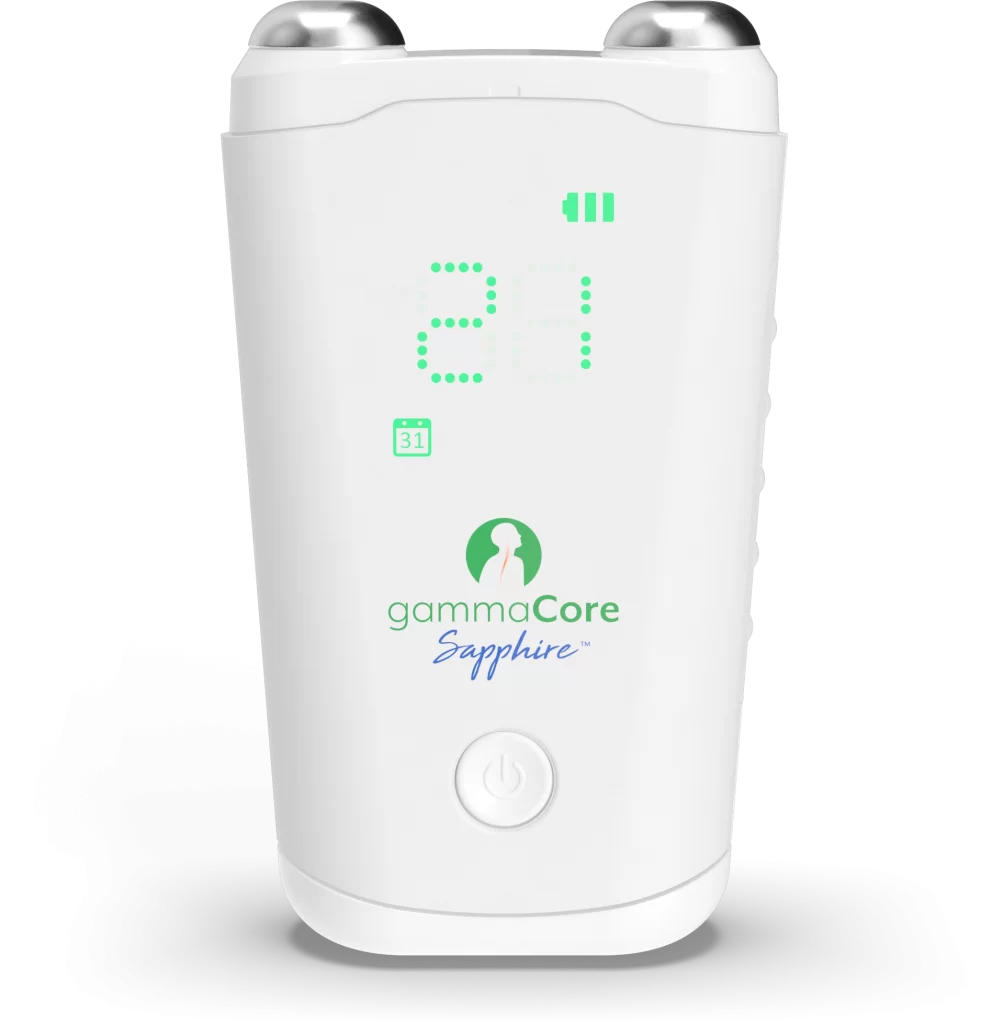
GammaCore is a non-invasive vagus nerve stimulator specifically designed to provide relief from migraine and cluster headaches. It’s a simple and easy-to-use device that’s applied externally to the neck to deliver gentle electrical stimulation to the vagus nerve.
Like Nuropod, GammaCore is a fully validated medical device, backed by numerous peer-reviewed clinical studies demonstrating its efficacy in the treatment of migraines and cluster headaches. Patients using GammaCore have experienced significant reductions in the frequency and severity of their headaches, with some reporting relief within 15 to 30 minutes of use. This makes it a valuable tool for those who suffer from debilitating headache conditions and are seeking a non-drug option for managing their symptoms.
The device is also sleek, compact, and portable, allowing for convenient use whenever you need it.
However, it comes with a couple of big drawbacks. First, you need a prescription from a doctor to purchase it, so you’ll need to pay for a doctor’s visit. Also, not all EU countries reimburse that appointment. Then, GammaCore is quite expensive, particularly if insurance coverage is not available to cover the costs. In the US, you can buy a preloaded GammaCore device for $450, but once those 3 months run out you’ll need to purchase more sessions. The refills cost $600 for every 3-month period after that. So if you want to use GammaCore for preventative care over several years, it will cost you thousands of dollars.
Also, GammaCore is designed to specifically treat migraines and cluster headaches, so people looking for relief from other conditions or symptoms caused by a dysregulated nervous system should look elsewhere.
Overall, GammaCore stands out as a robust, clinically supported option for vagus nerve stimulation for people seeking an effective, non-invasive treatment for migraine and cluster headaches. However, you need to consider the long-term costs when making your decision.
Key Features & Observations:
- Clinically certified device
- Simple and sleek device
- Can be challenging to locate the correct position on the neck
- Rapid relief (patients experience results in 15 minutes or less)
- Adjustable stimulation settings
- Minimal side effects in clinical studies
- Only validated to treat migraines and cluster headaches
- Expensive and ongoing costs
- Requires a prescription from a doctor to purchase
Overview
| GammaCore | |
| How it’s used | Handheld stimulation through the neck |
| Ease of use | Good |
| Targeting the vagus nerve | Non-specific targeting on the neck |
| Battery life | 6-7 hours for a full charge. Each device is preloaded with 93 days of consecutive treatment |
| Key risks | Minimal side effects |
| Clinical benefits | Provides effective relief for migraines and cluster headaches |
| Risk Profile | Very low |
| Scientific assessment | Highly recommended for people suffering from migraines or cluster headaches. |
Learn more about GammaCore
Sensate
Recommendation: Can be used as a supplementary tool
Price: 277 EUR (233 GBP)
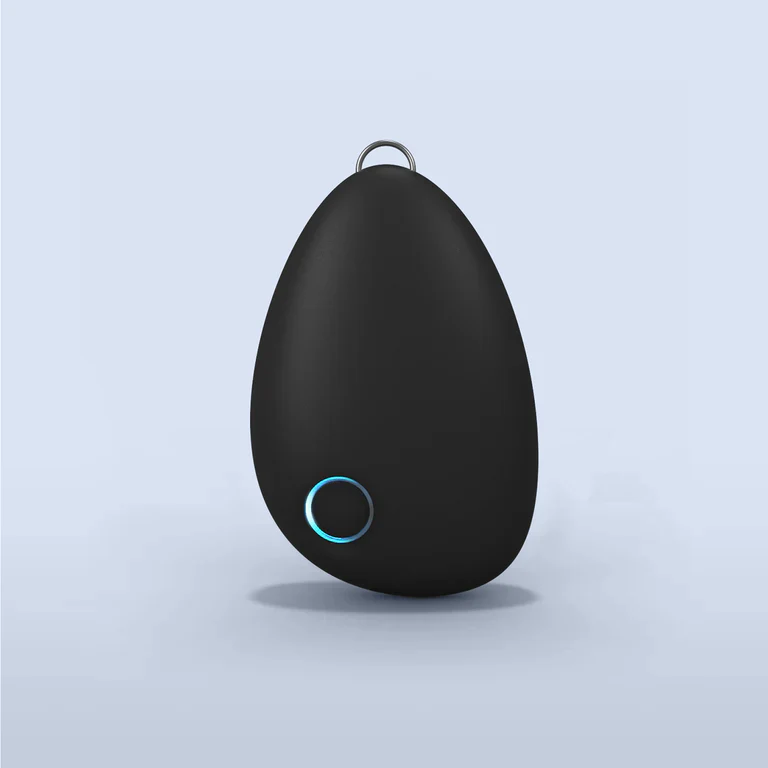
Sensate is technically not a vagus nerve stimulator, but a sensory stress relief device that uses vibrations and sound to lower stress. To be clear: Sensate is not a medical device. It’s a relaxation tool that will not give you clear and defined clinical benefits. So even though this product mentions the vagus nerve, it is not a validated device for vagus nerve stimulation.
Rather than directly stimulating the vagus nerve, this device claims to offer vagal toning to produce gradual results. Patients may start to notice the effects after around 10 minutes, but they’re rather subtle. Plus, Sensate lacks peer-reviewed clinical studies so any results felt from its use might be due to placebo.
Its grounding design resembles a large rock and differs quite a bit from other stress-relief devices. While it may not be the best option for those seeking meaningful results, Sensate does offer a unique multisensory experience combining touch and sound.
The device has a long battery life, allowing for extended use, and is built with durability in mind. However, since Sensate is not a vagus nerve stimulator its distinctive design and longer session times may not suit everyone’s preferences or lifestyle.
Key features:
- Gentle and safe design
- Provides a multisensory experience with touch, sound, and vibration
- Takes around 10 minutes to produce effects
- Long battery life
- Unique rock-inspired design
- Durable construction
- No peer-reviewed clinical studies
Overview
| Sensate | |
| How it’s used | Placed on the chest |
| Ease of use | Good |
| Targeting the vagus nerve | No evidence, but claims non-specific targeting on the chest in conjunction with deep breathing |
| Battery life | One week |
| Key risks | Low risk |
| Clinical benefits | No peer-reviewed studies |
| Risk Profile | Lack of safety studies, but probably low risk |
| Scientific assessment | Neutral. Low risk but no supporting evidence on benefits |
Learn More about Sensate
Pulsetto
Recommendation: Not recommended
Price: 250 EUR (209 GBP)
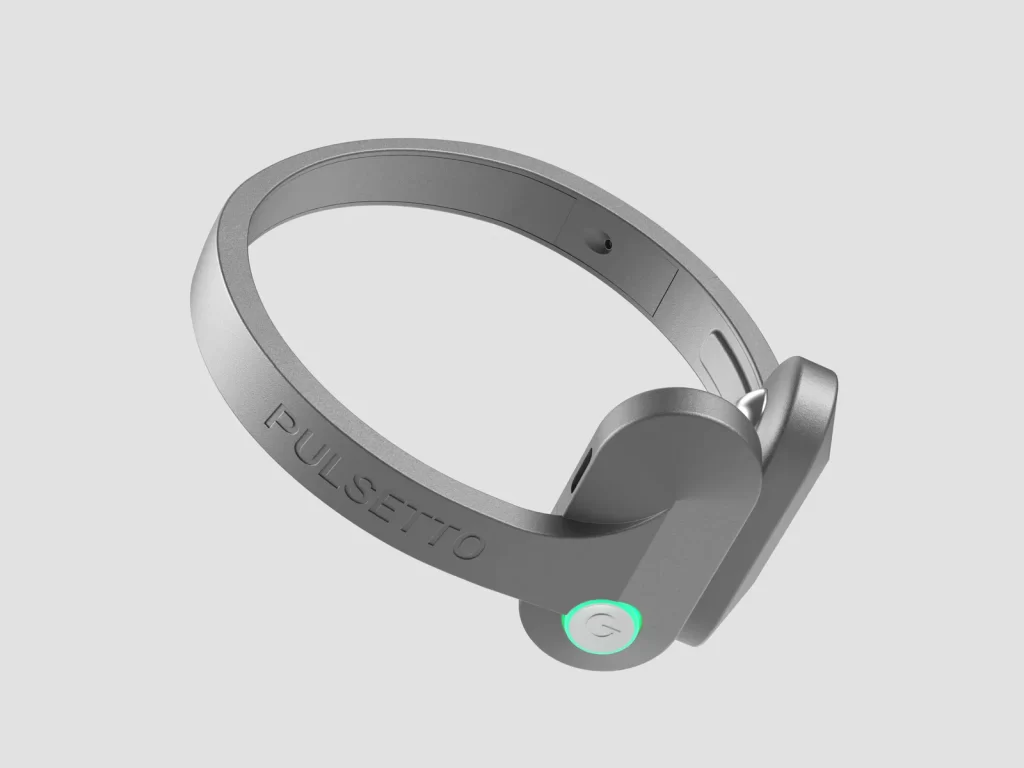
Pulsetto does not have medical device certifications or evidence that it activates the vagus nerve. However, it is a user-friendly device that offers different programs for users to target specific issues like stress, insomnia, pain management, and anxiety.
The key difference between Pulsetto vs. Nuropod or Gammacore is that Pulsetto makes claims about its device that it can’t substantiate. Without any peer-reviewed studies, there’s no way to trust that the device actually does what it says it will do.
While some consumers mistakenly rely on FCC certification as a proxy for safety, it’s important to understand that this certification only pertains to electromagnetic compatibility and radio frequency emissions, not the safety of electrical signals sent to the vagus nerve. This type of safety is rightly so under the remit of health bodies that also approve the drugs that we put in our bodies. In contrast, a CE-certified medical device ensures that a product meets strict EU health, safety, and environmental protection standards. Not all CE-certified devices are medical devices, and this distinction matters to guarantee the safety and efficacy of medical products.
Pulsetto uses high-intensity bilateral neck stimulation, which is untested for efficacy and safety. Since we didn’t find any clinical studies for the device, there might be a risk of cardiovascular side effects, stress reactions, and potential damage to the vagus nerve. If you are looking to try a device at the neck, we’d recommend putting your safety first and choosing Gammacore.
We evaluated Pulsetto’s programs and detected no difference between them, suggesting that this is deceptive marketing. Without any meaningful clinical research, we couldn’t verify the efficacy of their programs.
So while Pulsetto is easy to use, the lack of double-blind clinical studies on the device and potential risks put this one at the bottom of our list with a warning on use.
So to wrap this up, if you’re looking for a relaxation product, Sensate is lower risk. If you are looking for a neck-based product, GammaCore is a safer and likely more effective choice.
Key Features:
- Paid app with subscription and programs to target specific issues
- Design is difficult to adjust on the neck
- Not very portable
- Battery life only lasts for one week
- Claims quick-acting results in 4 minutes
- Uses bilateral neck stimulation which is untested and may carry the risk of cardiac side effects
- Permanent discounts on the website seem to be fake
- They seem to copy user testimonials in ads from other companies
Overview
| Pulsetto | |
| How it’s used | Worn on the neck |
| Ease of use | Good |
| Targeting the vagus nerve | Non-specific targeting on both sides of the neck |
| Restrictions on use | Not specified |
| Battery life | One week |
| Key risks | Lack of safety studies, potential risks of cardiovascular side effects, stress reactions, or damage to the vagus nerve. |
| Clinical benefits | No peer-reviewed studies |
| Risk Profile | High |
| Scientific assessment | Recommend to avoid use based on risk profile. |
Mental and physical well-being are essential to living a healthy, happy life. Recently, vagus nerve stimulation (VNS) has been gaining popularity as a non-invasive therapy to support overall wellness.
The vagus nerve is responsible for regulating heart rate, blood pressure, digestion, respiration, and many other bodily functions, making it a crucial component of our nervous system.
Vagus nerve stimulation is a groundbreaking approach to enhancing overall well-being. Stimulating the vagus nerve, which plays a crucial role in the functioning of the parasympathetic nervous system, can quickly lead to a significant reduction in stress, improved mood, enhanced cognitive function, improved gastrointestinal function, and more––all without drugs or psychotherapy.
Historically, vagus nerve stimulation required surgical intervention where a device is implanted in the chest with wires leading to the neck to directly stimulate the nerve. However, this method is costly, invasive, and carries surgical risks.
In recent years, at-home VNS devices have emerged as a more accessible and affordable alternative, allowing people to take control of their mental and physical health from the comfort of their own homes.
However, due to the social media hype around the vagus nerve and that strict regulations around vagus nerve stimulation are only starting to develop, many devices started popping up with little evidence of safety and efficacy. That’s why our team put together this extensive analysis that cuts through the noise and determines the safest and most reputable device for vagus nerve stimulation.
The Challenge of Precise Targeting in Vagus Nerve Stimulation
Imagine trying to play a symphony using a piano with many of its keys hidden under a cover. Each key, when pressed, produces a distinct note, but with the cover in place, striking the right keys at the right time to create a harmonious melody becomes incredibly challenging. Adding to the complexity, the piano can only be accessed through specific, narrow openings and has 100,000 keys. This analogy reflects the challenges faced in vagus nerve stimulation (VNS) therapy. The vagus nerve is like the piano, with its numerous fibers representing the keys, each linked to different bodily functions. The challenge lies in targeting the correct fibers at the precise time and through the appropriate access points to produce the desired therapeutic effects without causing unwanted side effects.
Understanding the Vagus Nerve’s Complexity
The vagus nerve is one of the most complex and multifaceted nerves in the human body. Originating in the brainstem, it extends down through the neck and into the abdomen, innervating multiple organs along the way. It plays a crucial role in regulating the unconscious (autonomic) nervous system, heart rate, gastrointestinal function, immune response, and mood, among other things. This vast network of functions is controlled by approximately 100,000 fibers within the vagus nerve, each with specific roles.
The Difficulty of Precise Targeting
In VNS, electrical impulses are used to target specific fibers in the vagus nerve, aiming to project to the brain and other organs in the body to elicit therapeutic responses for a variety of conditions such as epilepsy, depression, heart disease, and inflammatory diseases. However, the nerve’s intricate structure poses significant challenges. Targeting the right fibers to achieve the desired effect without activating other off-target effects that could be dangerous or cause adverse reactions is akin to pressing the correct piano keys at the right place at the right time, where certain keys are responsible for the beating of our heart, breathing of our lungs and encoding of information in our brain.
Types of Vagus Nerve Stimulation Devices
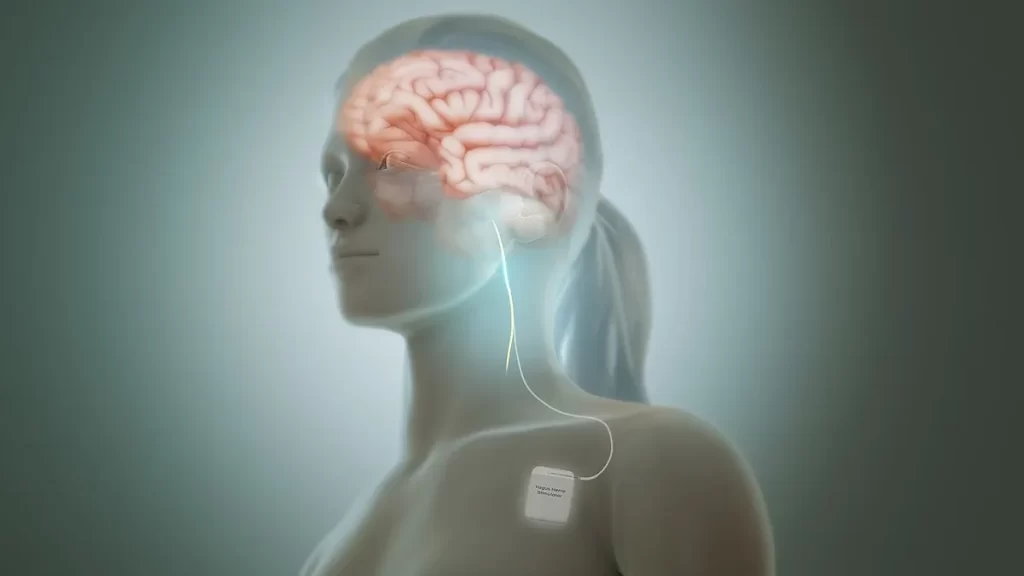
Targeting the vagus nerve is not easy. A device can emit an electrical signal to an area of the skin, but that signal doesn’t necessarily activate the vagus nerve. Only placebo-controlled clinical studies measuring vagus nerve activity can prove that a device actually stimulates the vagus nerve in a medically significant way.
There are a few different ways in which devices claim to stimulate the vagus nerve. The table below shows the methods, in this case, vibration or electrical impulses, as well as the target locations.
| Method | Vibration | Electrical impulses | Electrical impulses |
| Target site | Chest | Cervical (neck) | Auricular (ear) |
| Device | Sensate | Gammacore Pulsetto | Nuropod |
Ear vs Neck
The best and most well-researched is a method developed by a company called Parasym (who developed the Nuropod device); targeting the auricular branch of the vagus nerve on the left ear tragus. Tragus of the ear is richly innervated by the Vagus Nerve and it contains only sensory fibres. This means that signal from this area flows directly to the centres in the brain stem responsible for modulating the relaxation response of the parasympathetic nervous system with low risk of off-target effects
Attempting to stimulate the vagus nerve around the neck is difficult because it’s deep in the neck and not easy to access non-invasively. The neck is a complex and delicate area of the body, with vital structures like the carotid arteries, other cranial nerves, and jugular veins, as well as sympathetic (fight or flight) nerves so precise targeting is essential. Attempting neck stimulation without precision poses significant risks, including activating motor vagal fibres that directly influence the heart and can even stop its beating, resulting in extreme cases in palpitations, bradycardia or even cardiac arrest severe cardiac complications. Mayo Clinic researchers warned in the leading scientific journal, Scientific American, that tampering with the vagus nerve with unlicensed medical devices can potentially result in cardiac arrest or sudden death.
For this reason, the FDA-approved labeling for GammaCore’s vagal neuromodulation device targeting the neck specifies that they should only stimulate the left vagus nerve in the neck area inside the carotid sheath, below where the superior and inferior cervical cardiac branches separate from the vagus nerve. Other than GammaCore, no other neck stimulation device meets the FDA’s safety criteria. Pulsetto is worn on both sides of the neck, but there’s no peer reviewed studies on their device, which means safety of this stimulation cannot be established.
Electrical stimulation vs Vibration
Then there are devices like Sensate which use vibration, not electrical current, which is a very indirect approach. The vagus nerve can be thought of as a communication highway where the language spoken is in electrical signals. Vibration is a different language so the signals are not precise or easily translatable. It can be thought of as trying to do CPR to restart the heart rather than using a defibrillator. There is no peer-reviewed research supporting the claims or the effectiveness of Sensate.
Nuropod’s device targets the vagus nerve via the auricular branch of the left ear. Nuropod’s targeted signal delivery safely activates pathways for modulation of the autonomic nervous system and immune system––which is supported by randomized placebo-controlled clinical trials. Nuropod’s proprietary, Auricular Vagal Neuromodulation Therapy (AVNT) reaches the brain and activates the parasympathetic nervous system centres in the brain stem. This means that instead of stimulating directly various efferent fibres of the vagus nerve, Nuropod stimulates the headquarters of the parasympathetic system in the brain without direct action on the peripheral organs hence allowing peripheral mechanisms to act in a safer fashion.
Modulation vs Stimulation
When it comes to stimulating the vagus nerve, more (or faster) does not mean better. Too much vagal activation can result in side effects such as headaches, drowsiness, nausea, diarrhoea or slow heart rhythm. The calm state and health benefits of high vagal activity are achieved in the state where there is proper balance in the nervous system and right amount of vagal activation. What is more, each nervous system is different, changes day by day and follows a circadian rhythm. Devices such as Gammacore or Pulsetto deliver strong current and boast fast results in a few minutes. However, this might put patients with dysregulated nervous systems at an increased risk of side effects, these patients may therefore need more careful and precise stimulation.
Sensate on the other hand offers a light vibration, while Nuropod has precise modulation control with 45 levels so each person can adjust vagal activation based on their needs on a particular day with maximum safety.
Safety Studies & Medical Device Certification
Sending electrical signals to the vagus nerve that have not been evaluated in clinical trials and approved by institutions such as the FDA or EMA (CE) may contribute to the ineffectiveness of the therapy or put patients at risk of causing permanent damage to health.
Even a slight change in the electrical signals will affect the physiological reaction, ranging from (best case) no effect to (worst case) complications related to heart activity (sudden cardiac death or arrhythmia), nerve damage, or worsening in chronic health symptoms. That is why it is so important to use certified medical devices like Nuropod or GammaCore that underwent rigorous clinical trials to ensure safety & efficacy.
Pulsetto and Sensate are not medical devices. While for a vibration gadget like Sensate this might not be an issue, Pulsetto uses electrical current and lack of peer-reviewed clinical trials or safety standards might put patients nervous systems at risk. The company itself lacks transparency in this context as well using other certifications (FCC) to pretend they have been evaluated for safety.
There are many types of certifications, but only CE-certified Medical devices are tested for safety when it comes to using them to achieve health outcomes.
It’s important to note that not every CE-certified device is a medical device. CE certificates can be granted for different categories of products including toys, weighing scales and radios. For example, Sensate is a CE-certified device, but it is NOT a medical device, while Nuropod is a CE-certified medical device.
How to Choose a Vagus Nerve Stimulator

With a variety of different devices on the market, it’s important to do the proper research and make the choice that’s right for you. Most importantly, you need to be sure that the intervention you’re looking at has been clinically proven to target the vagus nerve.
Here are a few of the key factors to consider when making a decision:
- Consult with your doctor
Before starting any new medical intervention, it’s always a good idea to consult with a medical professional first. For vagus nerve stimulation, choose a neurologist or specialist who is familiar with VNS devices, so they can correctly advise you on if it will help your specific condition. - Compatibility with your condition
VNS devices are designed to improve specific conditions, including depression, chronic fatigue, gastrointestinal issues, and brain fog. Make sure that vagus nerve stimulation has been studied and evaluated for its effectiveness for your specific health needs. VNS devices also have different stimulation locations, such as the neck and ear. Sensate, which is not a VNS device, claims to stimulate it through the chest. However, Nuropod’s AVNT approach and Gammacore’s approach both have clinical evidence of precise targeting and safety. Other approaches at any location are at best playing the piano out of tune and at worst actively dangerous. - Safety & Medical Device Status
Many devices claim to be VNS devices and be safe, but it’s important to evaluate the clinical research done on each device to understand its safety profile. Sensate and Pulsetto say that they activate the vagus nerve, but they don’t have any clinical evidence to confirm it. Different methods of vagus nerve stimulation are associated with different side effects too, so it’s good to understand all the risks before you buy. Devices that have obtained certified Medical Device status are key––this certification requires rigorous quality testing and safety studies to ensure that they don’t harm the nervous system. - Effectiveness & Research
Be sure to look for devices backed by clinical research and ideally, placebo-controlled trials. A reputable device will have published research to back up its claims. Randomised placebo-controlled testing ensures that a device’s effects are not based on placebo, giving confidence in the device’s actual therapeutic benefits. Similarly, peer-reviewed studies reduce the risk of biased results and prove the credibility of the device tested.
Many devices quote generic VNS research but they haven’t conducted any safety and efficacy studies on their device. Just because a device emits an electrical current where the vagus nerve is located, doesn’t guarantee that it activates the vagus nerve or impacts it positively. Most research on vagus nerve stimulation was done with invasive methods, not portable devices. So a handheld device that references invasive VNS research is falsely representing the data to sell their product. - Stimulation vs Modulation
It’s also important to be aware that some devices, like Pulsetto or GammaCore, provide high-intensity stimulation which may increase the chance of side effects and may harm people with chronic conditions whose nervous systems are already dysregulated. Nuropod with 45 energy levels offers precise control of modulation to provide the same benefits with fewer risks. - Price
The device you choose must fit in your budget. Some devices have a subscription model that requires ongoing payments over time. Others like Nuropod and Sensate are one-time purchases. Because the benefits of using VNS require consistent use, the more they are used, the better the outcomes. Therefore, when considering getting a device, think long term how the costs of long term use would stack up. Taking Nuropod as an example, the cost of the device averages out to approximately 2 EUR per day over a year, and after that there are no more payments. Meanwhile, GammaCore is preloaded with 3 months of sessions. After that, you’ll need to purchase more sessions to continue using it. Pulsetto offers a paid app subscription, so long term costs of use might add up.
Comparison Summary
Devices like Nuropod, GammaCore, Pulsetto, and Sensate offer varying approaches, safety, and effectiveness in vagus nerve stimulation. Depending on your specific needs, risk profile, and budget, you can select the device that best meets your needs. For us, Nuropod emerged as the clear winner of our evaluation. Be sure to check with a healthcare professional if you have any questions or concerns about vagus nerve stimulation.
Here are the websites for each of the devices, ranked by the results of our evaluation:
1. Nuropod
2. GammaCore
3. Sensate
4. Pulsetto
The article does not in any way constitute as medical advice. Please seek consultation with a licensed medical professional before starting any treatment. This website may receive commissions from the links or products mentioned in this article.

